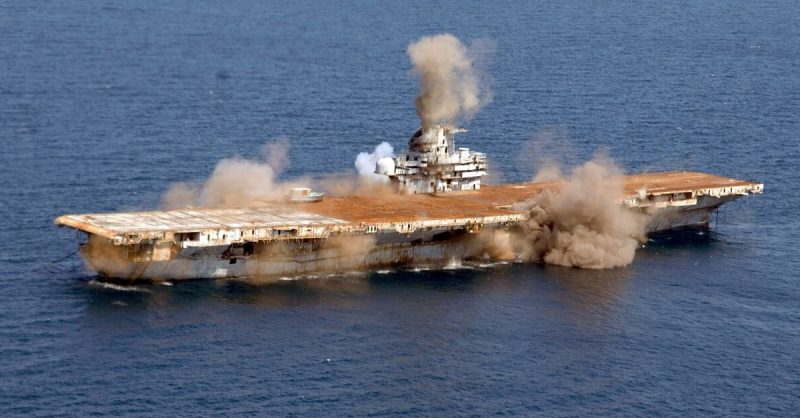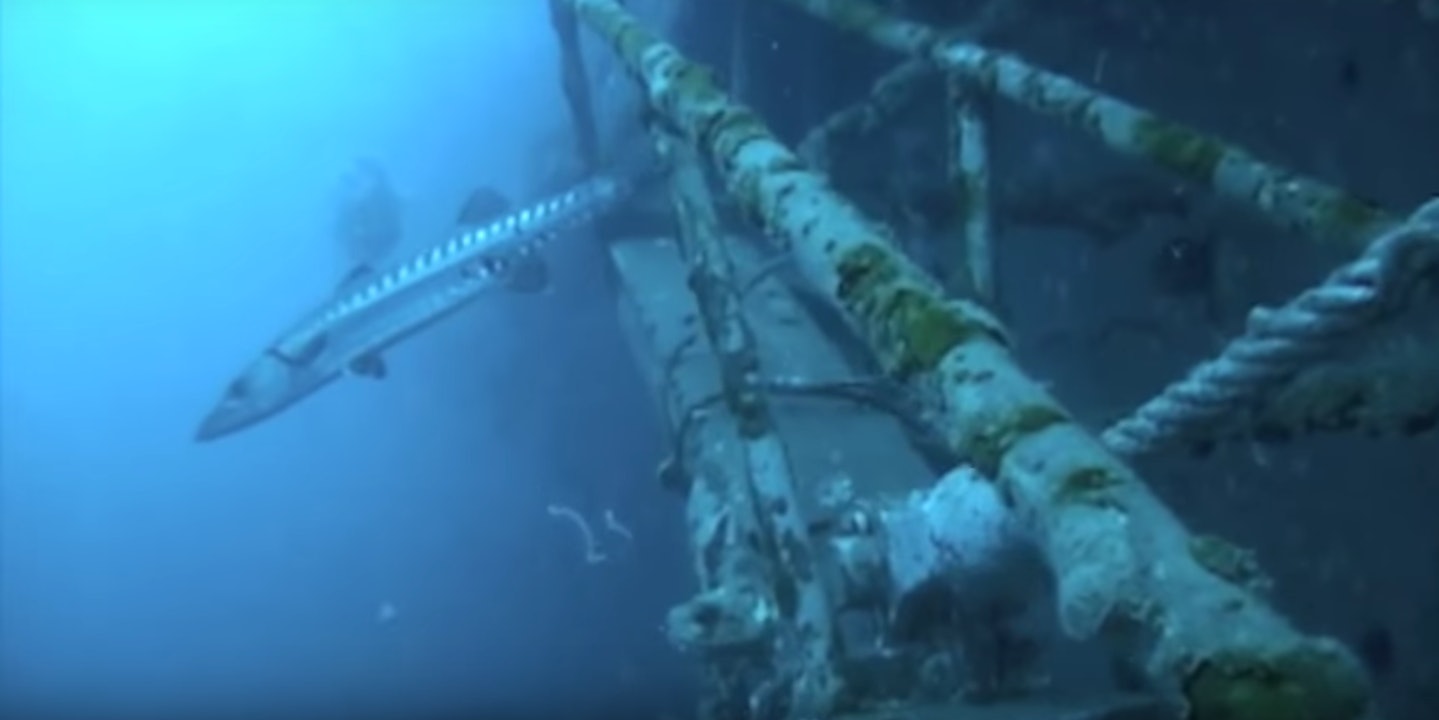
US Blows Up and Sinks Its Own Warship
The Sinking of the Aircraft Carrier USS Oriskany
(March 20, 2020) — Onlookers watched as the decommissioned aircraft carrier Oriskany arrived in Pensacola, Florida on Dec. 20, 2004 from Corpus Christi, Texas. The Oriskany was the Navy’s first ship to be sunk under the authority provided under the fiscal year 2004 National Defense Authorization Act (Public Law 108-136) and was the largest ship sunk to become an artificial reef — to benefit marine life, commercial and sport fishing, and recreational diving off the Florida coast.
The USS Oriskany was once a fearsome presence in the Korean and Vietnam wars, but the ship hadn’t served the US Navy in more than 30 years. But, the Oriskany had one final mission, before she’s laid to rest — as a salvage crew races the clock to strip the last of her riches.
Sinking Of An Aircraft Carrier
(September 20, 2017) — The film, “The Sinking of an Aircraft Carrier,” follows a demolition team’s mission to sink the USS Oriskany, a 900-foot long aircraft carrier, the most complex and best built ship in naval warfare, and to create the largest artificial reef in the world.
Battling through four-inch-thick steel plating and hazardous waste, the team discovers the secret of sinking an aircraft carrier, and in the process, writes a new chapter in marine demolition.
The USS Oriskany was built not to sink, but to withstand missiles and bomb hits during a war. She operated primarily in the Pacific into the 1970s, in both the Korean War, and the Vietnam War.
The US Navy aircraft carrier USS Oriskany (CVA-34) underway near Midway Atoll in 1967.
The courageous demolition team must go through tight tunnels throughout the ship, making sure everything is removed that could be harmful to the environment, meeting all safety codes.

Oriskany: 10 Years as ‘The Great Carrier Reef’
Melissa Nelson Gabriel / The Pensacola News-Journal
(May 16, 2016) — In the 10 years since the aircraft carrier USS Oriskany was intentionally sunk in the Gulf of Mexico near Pensacola, it has become both a top international dive destination and an underwater memorial to thousands of veterans who served on the famed carrier that is now the world’s largest artificial reef.
The ship has also become a final resting place for dozens of veterans who have had their ashes scattered over the site or had their sealed urns placed inside the ship since it was sunk 22 miles off Pensacola beach in about 220 feet of water.
Local dive enthusiasts say the Oriskany‘s size and complexity make it the Mount Everest of diving. Dubbed “The Great Carrier Reef” by locals, it has put Pensacola on the map of dive enthusiasts around the world.
“It’s a bucket-list dive for a lot of people. Scuba diving and coming down on something like that, it’s surreal,” said Chris Kimball, a Pensacola diver.
The Oriskany sunk to the bottom of the Gulf of Mexico on May 17, 2006, after Navy divers placed explosive charges throughout the ship and conducted a planned detonation. A flotilla of boats surrounded the ship and onlookers blew air horns and cheered as the ship dipped below the waves, water spraying from various compartments, before it sank to the bottom of the Gulf to became the world’s largest intentionally created artificial reef.
The sinking followed years of back and forth between the Navy, state of Florida, the Environmental Protection Agency and Pensacola-area leaders.
ARCHIVE DIVING VIDEOS
• Diving the Florida Panhandle Shipwreck Trail – YDT 14
• Diving the Florida Panhandle Shipwreck Trail – Black Bart
• Diving the Florida Panhandle Shipwreck Trail – USS Accokeek
• Diving the Florida Panhandle Shipwreck Trail – USS Chippewa
“The Navy had to have wanted it sunk here or it never would have happened,” said Douglas Hammock, captain of the dive charter boat H20 Below, who recalled endless community meetings with federal officials in the years before the sinking.
Hammock was a recreational diver who earned a living repairing boats before the Oriskany was sunk. In the decade since, he has retired from the boat repair business and started his dive charter business. He estimates he has taken more than 10,000 divers to the Oriskany site.
Hammock took his boat to the site the day after the sinking when divers went down to retrieve cameras that had been placed on the ship to capture the event. His fear was that the ship had laid over on its side after hitting the ocean floor. “It was a relief for all of us to find it sitting upright,” he said.
Hammock has taken divers from around the world to the Oriskany site. Many of the divers are the children of sailors who served on the Oriskany. He has also taken veterans’ families to the site for memorial services conducted by a Navy chaplain. The families often scatter ashes over the site or ask divers to place an urn with a sailor’s ashes inside the ship, he said.
“We’ve had several pilots who were stationed on the Oriskany come back and make the dive, but the veterans are getting in the older bracket now,” he said.
US Sen. John McCain flew off the Oriskany before he was shot down and taken prisoner during the Vietnam War. The ship is most remembered for a 1966 fire in the hangar bay. The fire, which ignited when a magnesium parachute flare exploded, killed 44 sailors.
Keith Benoit of Lafayette, Louisiana, was a 19-year-old disbursing clerk working below deck when the blaze erupted. “The fire is the thing that sticks with me more than anything,” said Benoit, who recalled sailors fighting the blaze for more than 18 hours. “The smoke was really thick and there was a strong odor from the magnesium,” he said.
Benoit is now in charge of the Oriskany veterans’ 2016 annual reunion, which will be held in Lafayette in October. Some veterans would have preferred to see the Oriskany turned into a museum, but the move was cost prohibitive, Benoit said. Most are pleased the ship has found a second life as an artificial reef, he said.
Dive master Taylor Wachtel has made more than 3,000 dives to the Oriskany and said she still has much more of the ship to explore. “I’d say I haven’t even seen a tenth of the ship,” she said.
Wachtel’s job is to accompany divers and look out for their safety. She also likes to point out the things to new Oriskany divers that they might not notice.
One of her favorites things are octopuses that curl inside pipes to protect eggs they have laid below. “You cannot really see them unless you shine your light in there. Sometimes they will reach out with one of their tentacles and that is very cool,” she said.
Wachtel has also seen a 300-pound Goliath grouper on the Oriskany, a 14-foot tiger shark and a massive whale shark. The top of the Oriskany‘s tower is 84 feet below the surface. At about 140 feet, the carrier deck is below the 130-foot limit for recreational diving. The Oriskany is not a beginner dive, said Wachtel, who encourages would-be divers to explore other area shipwrecks in shallower waters before attempting the Oriskany. “It is good to ease into diving the Oriskany,” she said.
Wachtel has taken divers from Europe, Brazil, Thailand, Australia and many other parts of the world to the dive site.
Diver and videographer Bryan Clark has made more than 200 dives on the Oriskany. Clark, an experienced technical diver, has explored the depths of the ship and documented the sea life surrounding it for the nonprofit Coastal Watch Alliance.
As parts of the ship deteriorate, holes are created that allow light to penetrate deeper into the structure spurring the growth of vegetation and drawing more sea creatures to the site, he said.
Clark said the coolest thing he has seen so far at the Oriskany site is a giant sunfish. The prehistoric looking fish can weigh up to 1,000 pounds. “It was amazing to be down there and see this crazy looking, humongous fish,” he said.
Craig Clark, an Ocala dive shop owner and diving instructor, has teamed with a group of friends to explore much of the Oriskany‘s interior. The men are certified cave divers. They breathe a mix of oxygen, nitrogen and helium to make the deep dives. The group, called Intruders of the Deep, offers tours of the interior of the ship for advanced divers. But Clark said they haven’t had many customers because of the complexity of the dive and the skill required.
The narrow passageways inside the ship can make it difficult to navigate. The men use different colored lines marked with arrows to help them find their way around. “You have to be careful not to disturb areas with a lot of rust or silt because that can create zero visibility,” he said.
Clark has been through most of the ship, but there are still areas he wants to explore. “There is so much of it to see. It is a massive structure,” he said.
The unexpected surprises are what keep him coming back. During one dive, he descended into the middle of tens of thousands of tiny jellyfish. Because much of the ship is made of aluminum, it is oxidizing quickly and starting to break down on the ocean floor.
“She is decomposing quickly. In another 20 to 30 years there might not be much left to dive,” Clark said.

Milestones in the History of the USS Oriskany
• Sept. 25, 1950 – Commissioned
• Oct. 26, 1966 – Hangar bay fire kills 44.
• Oct. 26, 1967 – Lt. Cmdr. John McCain flies off Oriskany in an A-4 Skyhawk, is shot down and taken prison of war in Vietnam.
• Sept. 30, 1976 – Decommissioned and sent to storage in Bremerton, Washington.
• 1989 – Recognized as obsolete and struck from the Naval Vessel Register.
• April 5, 2004 – Navy announces plan to transfer Oriskany to Florida for use as an artificial reef.
• December 2004 – Towed to Pensacola.
• June 2005 – Towed to Texas to ride out the hurricane season after delays from exhaustive ecological and health studies.
• March 2006 – Towed back to Pensacola for preparation for sinking.
• May 17, 2006 – Sunk in the Gulf of Mexico off Pensacola
New Life for the ‘Mighty O’
• Dubbed “The Great Carrier Reef” by locals
• Part of the Florida Panhandle Shipwreck Trail
• Largest artificial reef in the world
• Located 22 miles off Pensacola Beach at a depth of about 220 feet Is not a dive for beginners
Posted in accordance with Title 17, Section 107, US Code, for noncommercial, educational purposes.